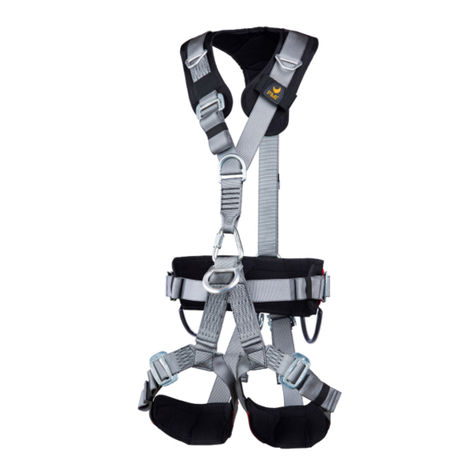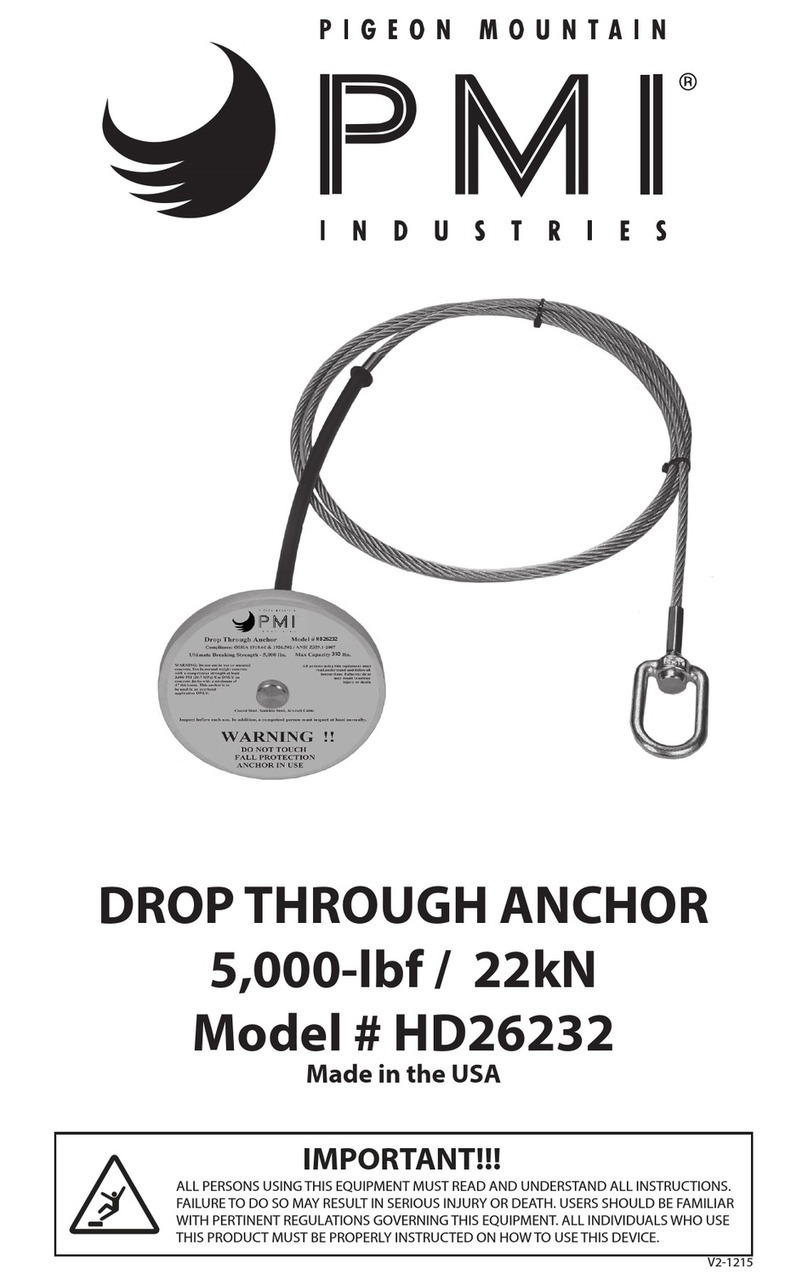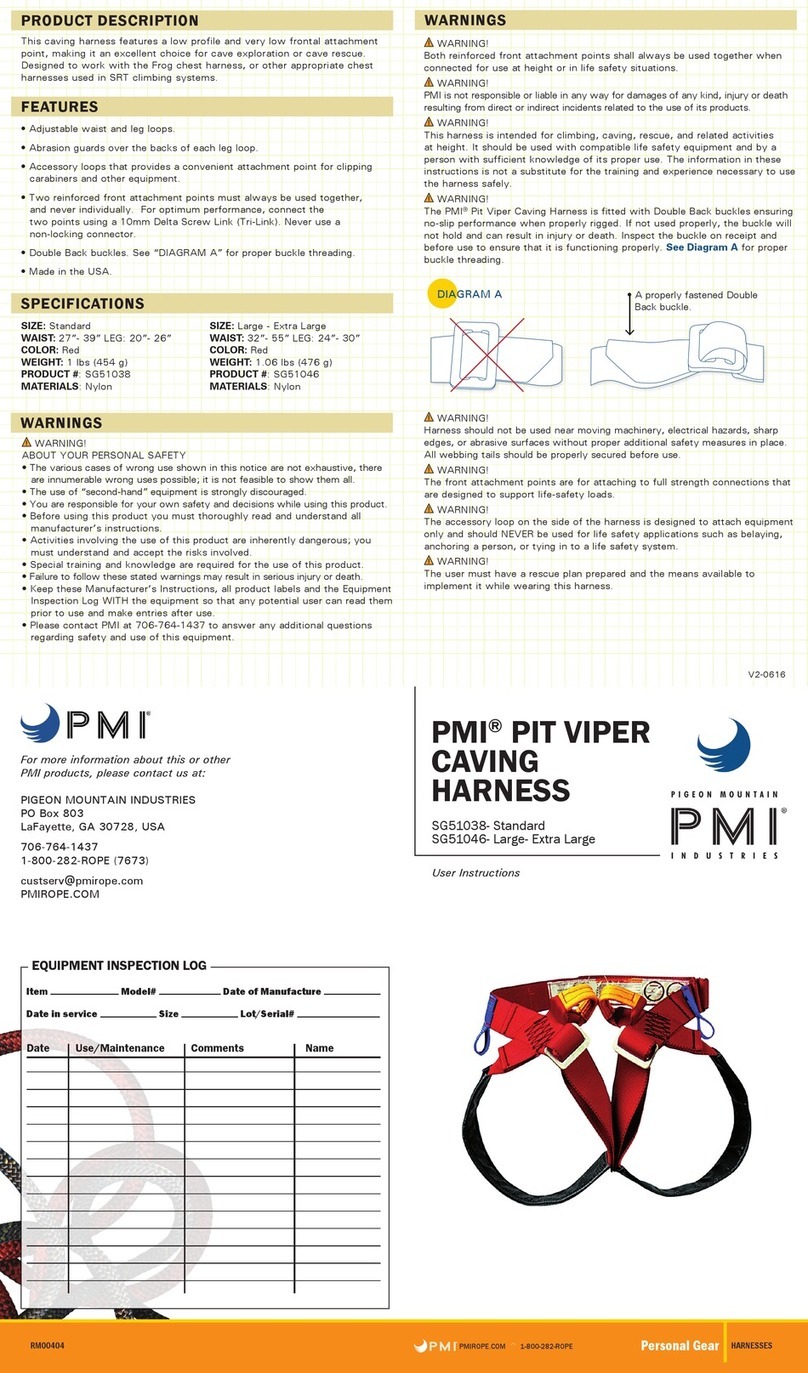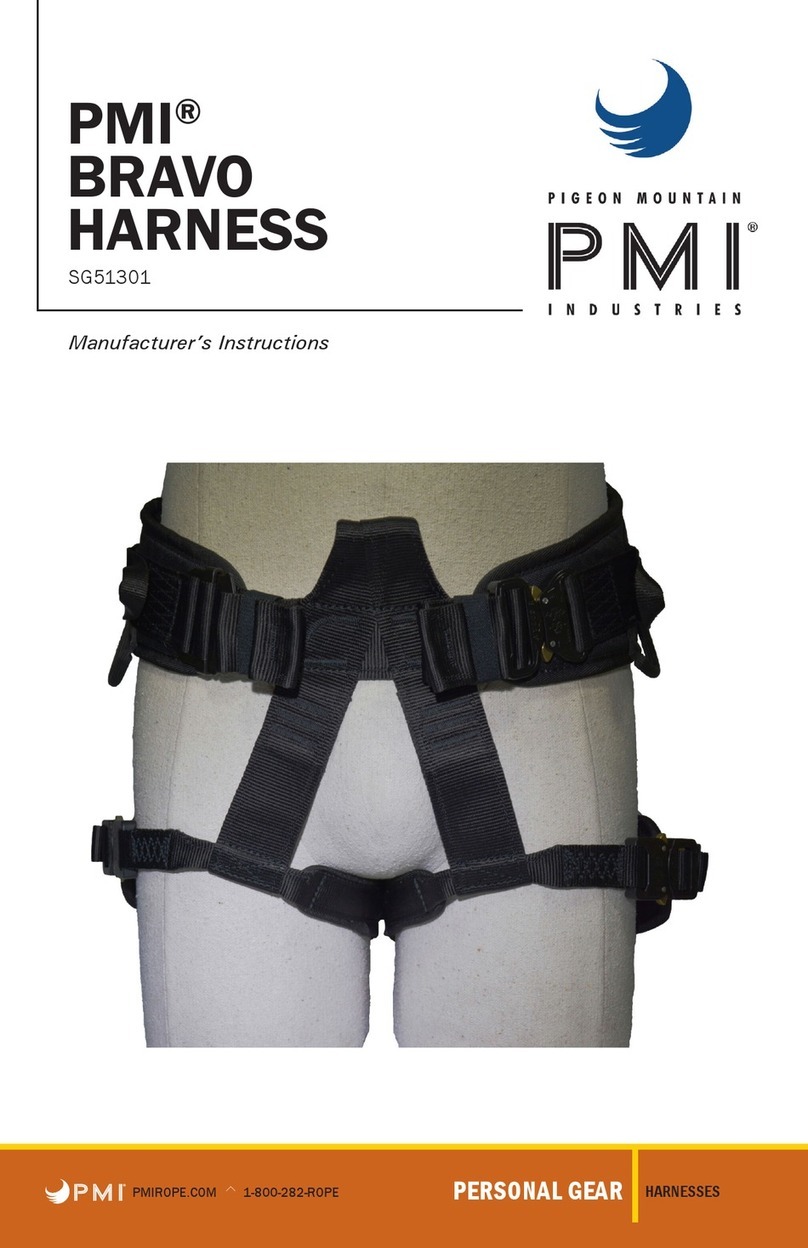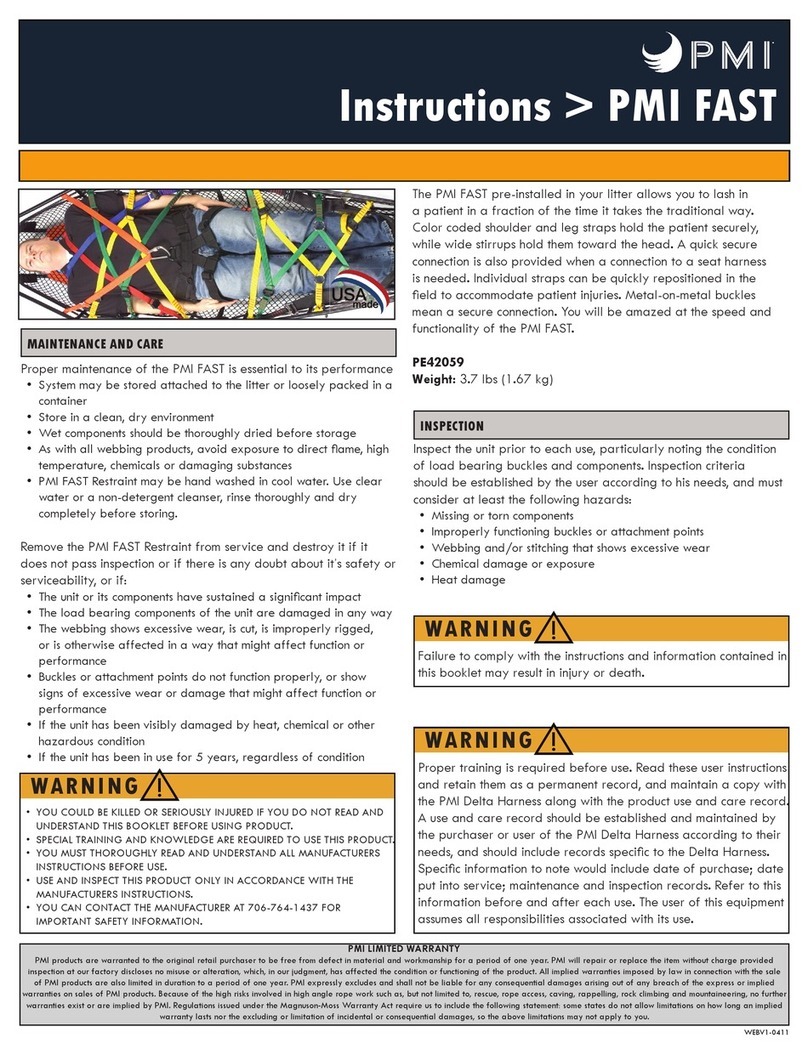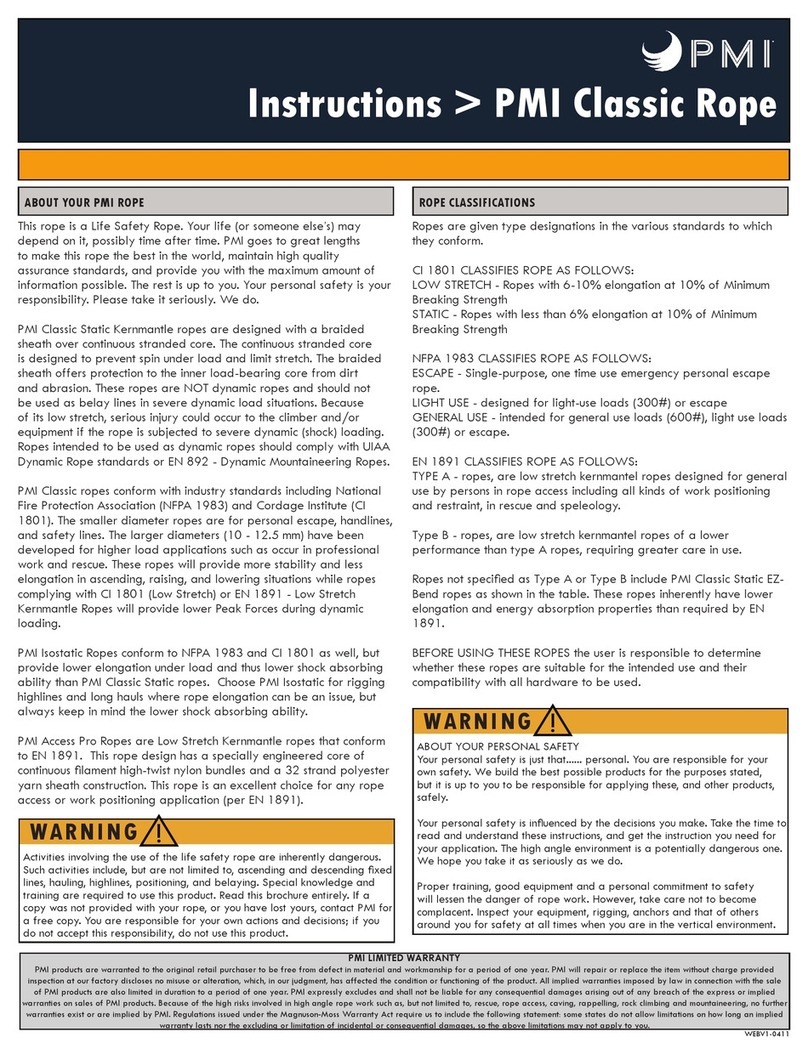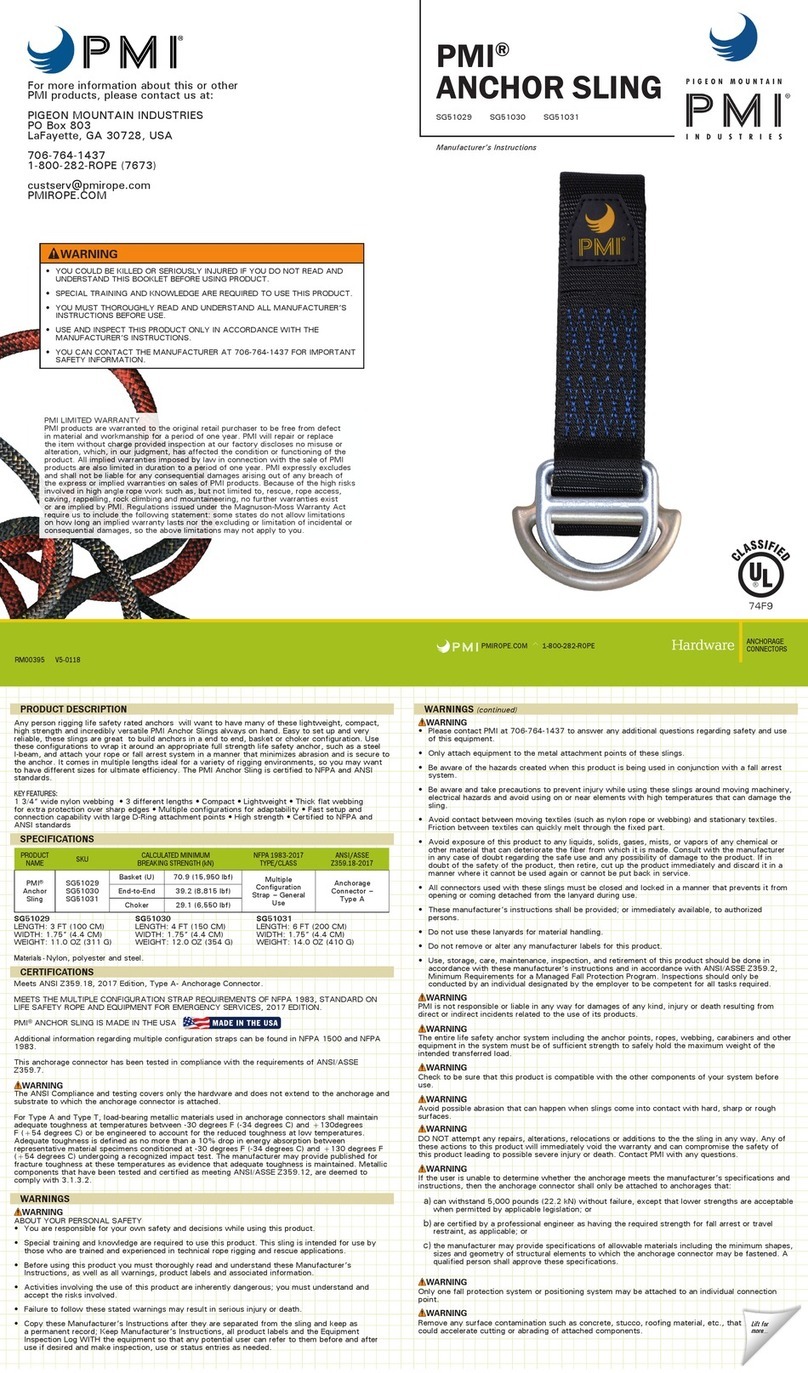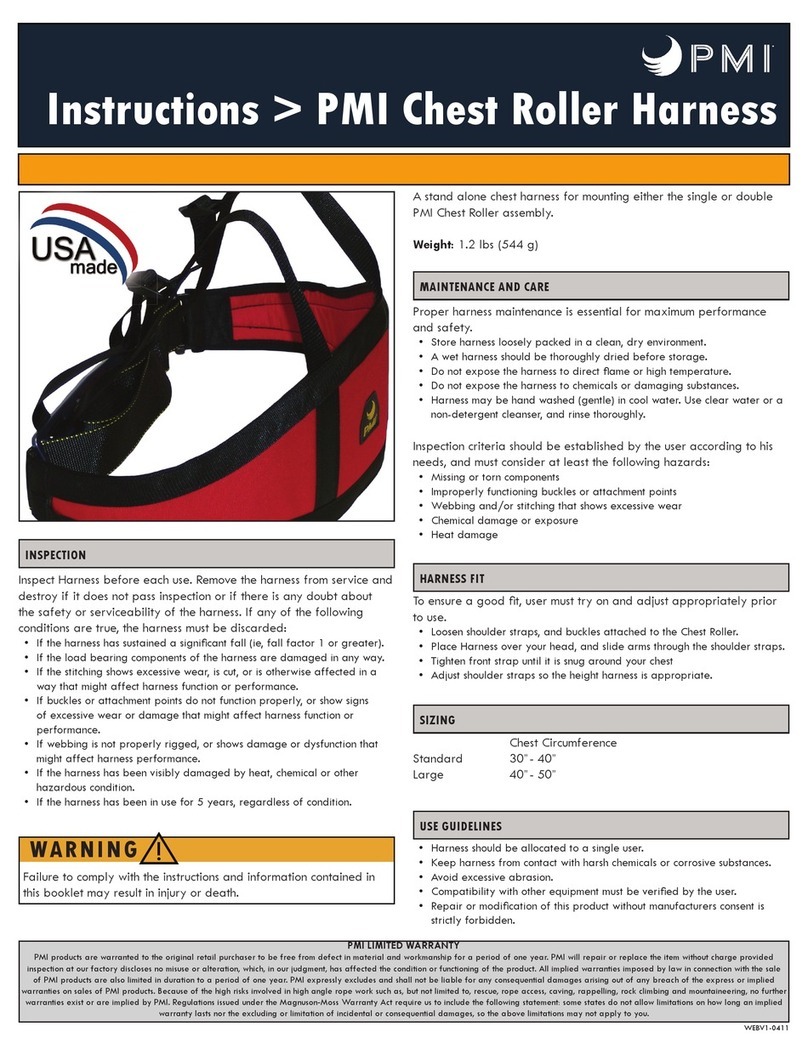
FITTING & USE
V3-0114
INSPECTION, CARE & MAINTENANCE
Your harness should be thoroughly inspected before each use. Any harness
that does not pass inspection should be immediately retired from service and
discarded/destroyed.
Inspections should include:
• Examination of all load-bearing components for signs of damage.
• Inspection of all stitching for signs of wear, fraying, breaks, loosened/pulled
threads, or cuts.
• Inspection of webbing for signs of cuts, burns, discoloration, broken bers,
hard/soft sections, or excessive wear.
• Examination of buckles and attachment points for proper function.
• Examination of all metal components for corrosion, damage or sharp edges.
• Inspection of webbing rigging and safety buckles to ensure that harness has
been properly assembled.
• Inspection for any signs of damage from heat, chemical exposure, or various
environments.
• Inspection of date of manufacture and date placed in service to determine if
retirement of harness is needed (See “Retirement Criteria” section).
• Inspections should be recorded and maintained in an Equipment Inspection
Log. A sample is provided in these instructions.
CARE AND MAINTENANCE
Maintaining your harness properly will provide a longer service life and ensure
the highest level of safety during use.
The following maintenance guidelines should be followed:
• Store harness loosely packed in a clean, dry environment.
• Thoroughly air dry a wet harness before storing it, never dry in a heated
dryer.
• Keep your harness away from exposure to direct ame or high temperatures
such as in a hot car.
• Prevent exposure of your harness to chemicals or other damaging
substances.
• No repairs or modications to this harness should be performed by anyone
other than the manufacturer, or warranty shall be voided and safety features
could be compromised.
Cleaning your PMI Spectrum Harness
Washing - If your harness is dirty, you can wash it by hand or in a front-
loading commercial washing machine. Use a PMI Laundry bag for keeping
the harness from getting tangled when washing in a machine. Wash harness
by using cool to warm water <30°C (<86°F) with a mild soap. PMI
recommends using PMI Rope Soap, otherwise non-detergent soaps are best.
Soap used should not contain any bleaching agents.
DO NOT:
• DO NOT use top loading washing machines with agitators because they
tangle/damage the harness severely and can cause damage to the machine.
• DO NOT use a commercial dryer to dry the harness.
• DO NOT leave a wet harness on a surface where contaminants may leach
(such as concrete).
• DO NOT expose the harness to exhaust fumes.
Disinfecting - Disinfection of a harness may occasionally become necessary,
such as when exposed to bloodborne pathogens. To disinfect a harness
from suspected bloodborne pathogens, PMI recommends following the NFPA
standard for cleaning rescue gear of bloodborne pathogens. Keeping in mind
that undiluted household bleach is known to damage nylon, NFPA calls for
using a diluted solution of household bleach to clean rescue gear exposed
to bloodborne pathogens. Add 60 ml of household bleach per 4 liters of tap
water. That’s about one quarter (1/4) cup of bleach per gallon of water. Be
aware that some commercial bleach solutions are stronger than the 1.5% that
is typical for household bleach. Soak the gear in the diluted solution for ten
minutes, then rinse thoroughly with tap water. The rinsing cycle is critical to
prevent any damage to the nylon from the bleach. It is good to soak the gear
in tap water for the same amount of time it soaked in the bleach solution.
Never store gear while it is wet.
WARNING!
The use of bleach over a long period of time, in repeated uses, can cause
damage to bers such as nylon. Disinfection of the harness using bleach
should be used sparingly and only when needed.
Drying - Dry your harness in a clean, dry area out of direct sunlight.
For best results, it should be hanged to dry in a low-humidity environment.
DO NOT leave a wet harness on a surface where contaminants may leach
(such as concrete).
Write It Down - Remember to record the cleaning on the Equipment Log.
Keep It Clean - Store your harness in a clean, dark, dry environment, away from
exposure to acids, other harmful chemicals, noxious fumes or other abuse.
RETIREMENT CRITIERIA
• RETIRE IMMEDIATELY any harness where the stitching is cut, torn,
excessively worn or visibly damaged.
• RETIRE IMMEDIATELY if harness has been in service for 5 years or more, it
must be retired even if a visual inspection reveals no concerns.
• RETIRE IMMEDIATELY any harness whose strength may have been
compromised during use.
• RETIRE IMMEDIATELY any harness which is subjected to a major fall or
uncontrolled or excessive loading.
• RETIRE IMMEDIATELY any harness with a manufacture date which is greater
than 10 years old, regardless of history and usage.
• RETIRE IMMEDIATELY any harness whose history and past usage you are
uncertain about.
• RETIRE IMMEDIATELY any harness that has been exposed to heat, direct
ame or excessive abrasion.
• RETIRE IMMEDIATELY any harness that has been exposed to liquids,
solids, gases, mists, or vapors of any chemical or other substance that can
deteriorate the harness materials.
• RETIRE IMMEDIATELY any harness that does not pass inspection.
• RETIRE IMMEDIATELY any harness that raises any doubt about its safety or
serviceability.
WARNING!
CUT RETIRED harnesses to discourage future use and discard it entirely. A
retired harness should not be stored, kept or maintained in such a way that it
could inadvertently be used again.
HOW TO PUT THE HARNESS ON CORRECTLY
• Loosen waist belt and leg loops by tilting the buckle and sliding the slack
tail end of the webbing towards the buckle. DO NOT unthread the webbing
from the buckle. The waist belt and leg loops should always remain one
continuous loop threaded through the buckles.
The design of this harness results in a variable “rise” (distance between leg
loops and waist belt) that can be easily adjusted at the leg loop safety buckles to
ensure that the harness sits comfortably and suspends the wearer properly. If the
rise is too short, there can be uncomfortable compression applied to the crotch.
This could also cause uneven top-heavy weight distribution which could result
in the wearer being ipped upside down. If the rise is too long, the harness can
put excessive compression above the hipbone. When adjusted correctly, this
harness positions the user comfortably in an upright, seated and slightly reclined
position. Please refer to Diagram E for proper t and rise adjustment.
• Tilt buckle to loosen straps.
• Pull tail end of webbing to
tighten straps.
DIAGRAM D
DIAGRAM C
DIAGRAM E
• Step through the top of the
waist belt, inserting a leg into
each leg loop with the buckles
facing out, in front of your body.
The rear straps should extend
from the tops of the leg loops to
the bottom of the waist belt.
• There should be no twists in
the straps and each leg buckle
should be positioned on the
webbing that extends toward
the outside of the leg, as
shown.
• Position the harness so that the
waist belt wraps over the top
of the hip bones and so that the
belay/rappel loop is at about belly
button level. Secure by pulling
on the tail end of the waist belt
webbing, as shown in Diagram E.
• Secure the leg loops comfortably
around the thigh by pulling on the
tail ends of the leg loop webbing.
Adjust the leg loops to determine
the proper rise.
• Ensure that the leg loops and waist
belt are comfortable but snug
enough so that the harness stays
rmly in the proper position. You
SHOULD NOT be able to slide the
harness down over the hips once
fastened correctly.
• Finally, adjust the rear straps so
that the slack is taken out.
PMI LIMITED WARRANTY
PMI products are warranted to the original retail purchaser to be free
from defect in material and workmanship for a period of one year. PMI
will repair or replace the item without charge provided inspection at our
factory discloses no misuse or alteration, which, in our judgment, has
affected the condition or functioning of the product. All implied warranties
imposed by law in connection with the sale of PMI products are also limited
in duration to a period of one year. PMI expressly excludes and shall not
be liable for any consequential damages arising out of any breach of the
express or implied warranties on sales of PMI products. Because of the
high risks involved in high angle rope work such as, but not limited to,
rescue, rope access, caving, rappelling, rock climbing and mountaineering,
no further warranties exist or are implied by PMI. Regulations issued under
the Magnuson-Moss Warranty Act require us to include the following
statement: some states do not allow limitations on how long an implied
warranty lasts nor the excluding or limitation of incidental or consequential
damages, so the above limitations may not apply to you.
Thank you for purchasing PMI products!












